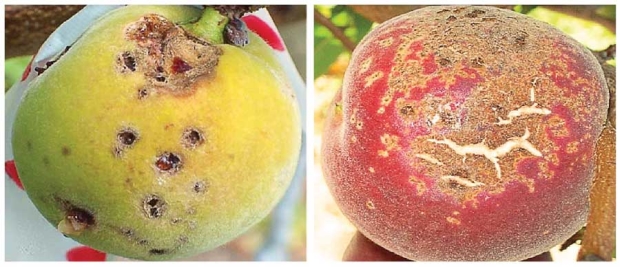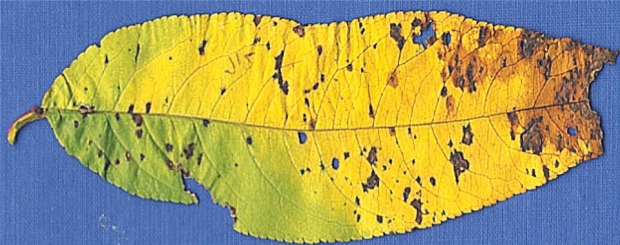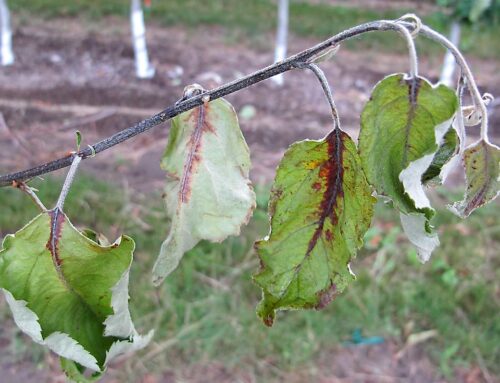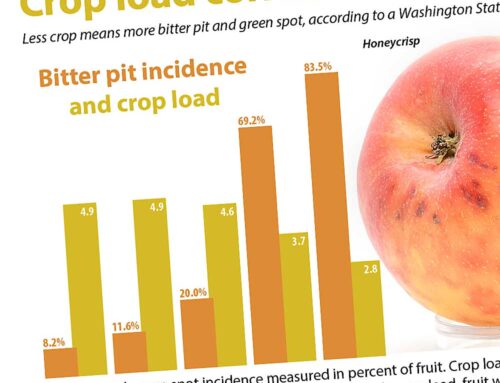
Bacterial spot symptoms typically appear about three weeks after petal fall. Early-season fruit lesions may extend all the way to the pit. After pit hardening, bacterial spot causes shallower lesions that may coalesce and cause the skin to crack. (Courtesy Sarah Bardsley Capasso)
The bane of peach and nectarine growers in the eastern United States, bacterial spot can lead to significant and sometimes total fruit loss, especially during the wet and warm conditions that the disease-causing bacteria favor.
Growers can, however, fight back with a management program that incorporates the active winter pruning of twig cankers, which can harbor large concentrations of the bacteria, called Xanthomonas arboricola pv. pruni (or Xap).
By removing the cankers, growers can significantly reduce the amount of bacteria — called the inoculum — that would otherwise thrive and spread throughout the tree and to adjacent trees during the following spring.
To remove the cankers, orchard workers first have to be able to recognize them, and unfortunately that is no easy task, said Sarah Bardsley Capasso, who spoke about bacterial spot during the Great Lakes Fruit, Vegetable, and Farm Market EXPO in Grand Rapids, Michigan.
She has been working on the disease as a graduate student in the Department of Plant Pathology and Environmental Microbiology at Pennsylvania State University.
“People who have been growing trees for 25 to 30 years have issues with identifying cankers,” Capasso said. That’s why the Penn State Fruit Research and Extension Center has held workshops on distinguishing between healthy wood and cankers.
Usually, she said, workers first notice cankers in the spring because, unlike healthy portions of branches, they don’t bear any leaves. Cankers will also look water-soaked, although they aren’t actually wet.
These darker, blacker sections, which are often at the tips of branches, enlarge as they age and, about three weeks after petal fall, may begin to cause the bark to crack and take on a slightly sunken appearance.
“What we think happens is that the bacteria originally enter the tree through the leaves and move through the leaves and underneath the bark where cankers form and where the bacteria overwinter,” she said. “Come spring, we’ll often see a lot of bacterial spot symptoms on fruit and leaves right around the cankers.”

The symptoms of bacterial spot on fruit are similar to those of peach scab, which is a fungal disease. On leaves, both copper injury and nitrogen deficiency look similar to bacterial spot. Distinguishing features of bacterial spot on leaves include angular-shaped lesions (rather than round) that are often surrounded by a yellow halo. As the season progresses, bacterial spot lesions may fall out of the leaf, leaving behind holes. (Courtesy Sarah Bardsley Capasso)
Although pruning of cankers can occur any time of the year, winter is opportune because much of the bacteria are holed up in the cankers at the same time that orchard workers are available to take on the labor-intensive chore of scouting for cankers tree by tree.
For removal, Capasso recommends cutting beyond the canker and a bit into the healthy wood. “A good rule of thumb would be about 6 inches beyond, if it can be spared, because the bacteria are going to be invading the healthy tissue without visible symptoms initially.”
Once severed, the cankers should be removed from the orchard. “Just take them to the burn pile and get rid of them that way,” she said. “If you put them in a dumpster or pile them up, you’re not really killing the bacteria.”
Even the most diligent canker-removal program, however, will not completely eliminate Xap.

Cankers can be difficult to identify in the winter, but a telltale characteristic is their darker, cracked and sunken bark. Workers should snip off the cankers, plus another 6 inches of healthy wood, and then remove the trimmings from the orchard. (Courtesy Sarah Bardsley Capasso)
For the best results, Capasso recommended a comprehensive management program, which includes:
—Locating new orchards in well-draining soils and avoiding low spots to lessen the wet conditions Xap favors. “Even small amounts of standing water in an orchard will become a big issue with bacterial spot,” she said.
—Planting cultivars that are less susceptible to the disease. “Remember that no cultivar is completely resistant to bacterial spot, so when the weather is wet and warm, for instance, even the most resistant cultivars may get some symptoms,” she said.
—Reducing tree stress by removing weeds, especially high weeds.
—Pruning trees to increase airflow within the canopy. This will help to keep leaves dry. “The faster you can dry the leaves, the less time you are going to allow for the bacteria to get into the tree,” she said.
—Spraying with copper, which is a proven treatment for bacterial spot, but combining it with other chemicals.
Field tests at Penn State showed success with copper alternated either with the biofungicide Serenade Optimum or with the phosphorus acid Rampart, or with copper mixed with hydrated lime.
These combinations reduced the phytotoxicity side effect that occurs with copper, and also helped to prevent the bacteria from developing resistance to copper.
Although rotations of copper and the antibiotic oxytetracycline are commonly used in orchards, the field tests showed oxytetracycline didn’t work as well as the copper programs under the strong disease pressure in southern Pennsylvania.
She cautioned that such field tests are site- and weather-specific, so growers may have different results with copper combinations.
Growers may not be able to have totally Xap-free peach and nectarine orchards, but Capasso reiterated that they should be able to greatly reduce the impact of bacterial spot if they follow a management strategy that includes removal of cankers.
“Overwintering cankers are large sources of inoculum. If you get rid of them, you will get rid of a lot of bacteria and will reduce the initial amount of inoculum in spring and the initial disease severity.” •
– by Leslie Mertz, Ph.D., a freelance writer based in Gaylord, Michigan.






When the spots fall to the ground do they cause infection? Should affected leaves be removed from the tree, hopefully before the spots fall? Or does it not perpetuate the disease when the spots fall?